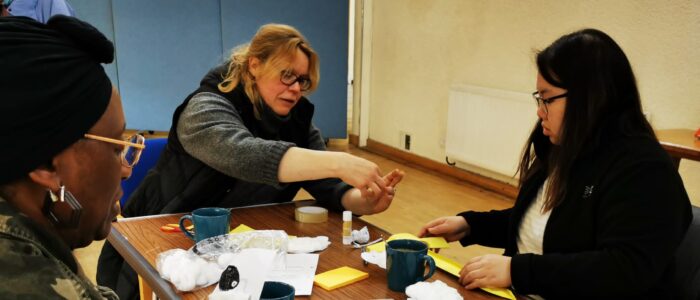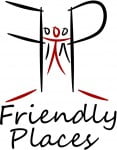Creative English: A Family Thing

 Over the summer I had the opportunity to tag along with the Creative English Lead Trainer, Anne Smith, and help out with running three family learning sessions. I jumped at the chance to get involved, as whilst I’ve worked with children in Primary Schools before, these sessions would cater for a wide variety of age ranges…from babies to children up to eleven years old. While many learners are unable to attend regular Creative English sessions over the summer due to childcare commitments, the summer provides a great opportunity to get the whole family involved, sharing in creative activities and learning English at the same time.
Over the summer I had the opportunity to tag along with the Creative English Lead Trainer, Anne Smith, and help out with running three family learning sessions. I jumped at the chance to get involved, as whilst I’ve worked with children in Primary Schools before, these sessions would cater for a wide variety of age ranges…from babies to children up to eleven years old. While many learners are unable to attend regular Creative English sessions over the summer due to childcare commitments, the summer provides a great opportunity to get the whole family involved, sharing in creative activities and learning English at the same time.
Each workshop was planned around a story, and started with an element of craft. This gave the learners the chance to create props that could then be used in the performance of the story that the workshop had been based on. This allowed everyone to participate and get a gist of what was happening in the session, even if they had a very low level of English. By using play dough to make beautifully presented bowls of fruit, or creating monster masks with outrageous hair styles and wild grimaces, learners were able to build their vocabulary while having fun and hopefully gaining some new ideas for things to do at home with their children.
 Once the participants had put their finishing touches to their props we were ready to get performing! In the first workshop we explored the story of ‘The Unreasonable King’, who demanded that a poor elderly person cook him a huge feast and make him a luxurious tent. We asked children to take on these roles, while the rest of the family became the villagers who help the old man accomplish the unreasonable tasks set by the king. Having a few simple moments of ‘call and response’ built into the story worked brilliantly, and everyone was soon miming sewing, chopping, cooking and even doing their very best (and loudest!) impression of a howling wolf. In the second workshop we told the story of ‘Monster Island’, with children transforming themselves using the masks they had made. Finally, we looked at ‘George and the Dragon’, using props such as a shield and sword, as well as things made during the craft activities, to bring the story to life. The performances were all very engaging and designed to help with speaking and listening skills. It was clear that the children were having a fantastic time and that parents were enjoying seeing their children joining in.
Once the participants had put their finishing touches to their props we were ready to get performing! In the first workshop we explored the story of ‘The Unreasonable King’, who demanded that a poor elderly person cook him a huge feast and make him a luxurious tent. We asked children to take on these roles, while the rest of the family became the villagers who help the old man accomplish the unreasonable tasks set by the king. Having a few simple moments of ‘call and response’ built into the story worked brilliantly, and everyone was soon miming sewing, chopping, cooking and even doing their very best (and loudest!) impression of a howling wolf. In the second workshop we told the story of ‘Monster Island’, with children transforming themselves using the masks they had made. Finally, we looked at ‘George and the Dragon’, using props such as a shield and sword, as well as things made during the craft activities, to bring the story to life. The performances were all very engaging and designed to help with speaking and listening skills. It was clear that the children were having a fantastic time and that parents were enjoying seeing their children joining in.
 We were based at a fantastic children’s centre in Goodmayes, East London. Liz, the project link worker, and other centre staff were very supportive, offering cups of tea and occasionally sneaking a peek at what we were up to! We were lucky to have a light and airy space to work in, with plenty of toys and resources around – but what really stood out to me from these sessions is how little you need to facilitate a fun, creative learning environment – within moments a bit of cloth and a few old, beaten up boxes had become a ferocious dragon ready for St George to slay.
We were based at a fantastic children’s centre in Goodmayes, East London. Liz, the project link worker, and other centre staff were very supportive, offering cups of tea and occasionally sneaking a peek at what we were up to! We were lucky to have a light and airy space to work in, with plenty of toys and resources around – but what really stood out to me from these sessions is how little you need to facilitate a fun, creative learning environment – within moments a bit of cloth and a few old, beaten up boxes had become a ferocious dragon ready for St George to slay.
One of the things I love most about working through drama is how quickly relationships and environments are transformed. At the start of the sessions learners would come in quietly and tentatively, listening to what they should do next and dutifully completing tasks. By the time the session was over, participants had taken it upon themselves to bang a drum to suggest a dragon’s thunderous footsteps, sorted out the chopping of fruit and pouring water, and were happily chatting away to someone they’d never met before. These moments can’t be planned for, and can only come about by encouraging the open, creative and responsive atmosphere that working through drama can provide. For me, this is where I see the ability to speak English and learners’ confidence (not just in relation to English) develop.


